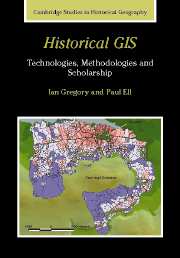Book contents
- Frontmatter
- Contents
- List of figures
- List of tables
- Acknowledgements
- 1 GIS and its role in historical research: an introduction
- 2 GIS: a framework for representing the Earth's surface
- 3 Building historical GIS databases
- 4 Basic approaches to handling data in a historical GIS
- 5 Using GIS to visualise historical data
- 6 Time in historical GIS databases
- 7 Geographic Information Retrieval: historical geographic information on the internet and in digital libraries
- 8 GIS and quantitative spatial analysis
- 9 From techniques to knowledge: historical GIS in practice
- References
- Index
1 - GIS and its role in historical research: an introduction
Published online by Cambridge University Press: 23 June 2009
- Frontmatter
- Contents
- List of figures
- List of tables
- Acknowledgements
- 1 GIS and its role in historical research: an introduction
- 2 GIS: a framework for representing the Earth's surface
- 3 Building historical GIS databases
- 4 Basic approaches to handling data in a historical GIS
- 5 Using GIS to visualise historical data
- 6 Time in historical GIS databases
- 7 Geographic Information Retrieval: historical geographic information on the internet and in digital libraries
- 8 GIS and quantitative spatial analysis
- 9 From techniques to knowledge: historical GIS in practice
- References
- Index
Summary
1.1 INTRODUCTION
Until the mid-1990s, most historians or historical geographers would not have heard of a Geographical Information System (GIS), despite its widespread use in other disciplines. Since then there has been a rapid increase in awareness of the potential of GIS in historical research, such that a new field, historical GIS, has emerged. This book will demonstrate that historical GIS has the potential to reinvigorate almost all aspects of historical geography, and indeed bring many historians who would not previously have regarded themselves as geographers into the fold. This is because GIS allows geographical data to be used in ways that are far more powerful than any other approach permits. It provides a toolkit that enables the historian to structure, integrate, manipulate, analyse and display data in ways that are either completely new, or are made significantly easier. Using these tools and techniques allows historians to re-examine radically the way that space is used in the discipline. As with any new approach, enthusiasm for GIS is not without risks. GIS originated in disciplines that use quantitative and scientific approaches in a data-rich environment. Historical geography is rarely data-rich; in fact, data are frequently incomplete and error-prone. As a discipline, historical geography employs both quantitative and qualitative approaches and is rightly suspicious of overly scientific or positivist methodologies. Further, many researchers are introduced to GIS as a software tool rather than an approach to scholarship.
- Type
- Chapter
- Information
- Historical GISTechnologies, Methodologies, and Scholarship, pp. 1 - 20Publisher: Cambridge University PressPrint publication year: 2007



